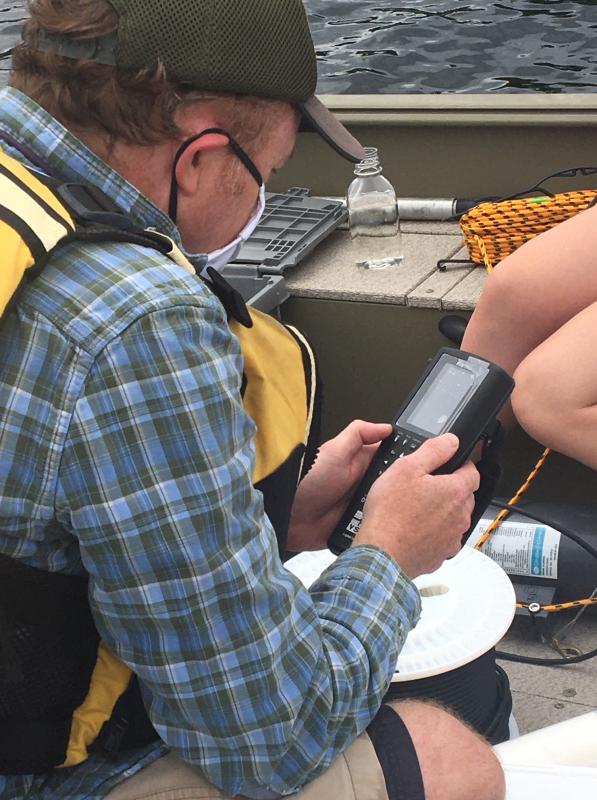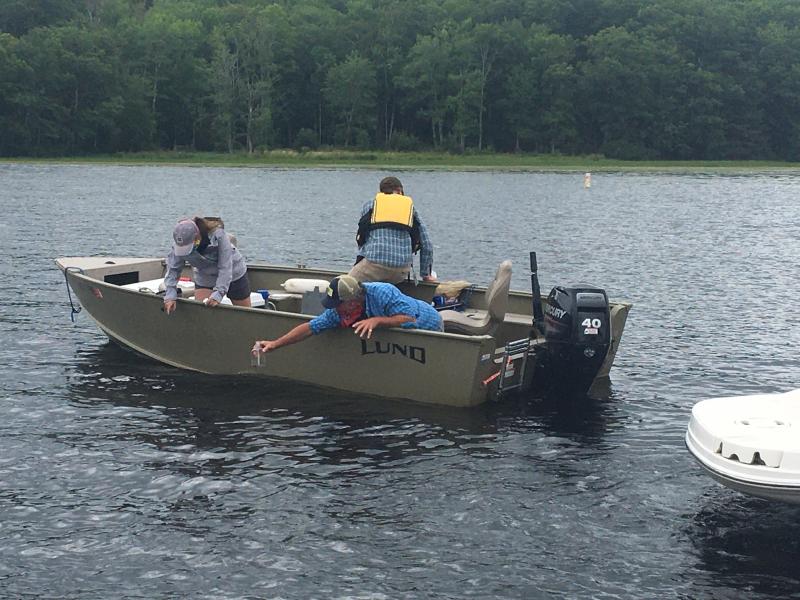Officials concerned about bacteria in Damariscotta Lake
 Dr. Peter Countway of Bigelow Laboratory evaluates a water sample from Damariscotta Lake. Courtesy of Midcoast Conservancy
Dr. Peter Countway of Bigelow Laboratory evaluates a water sample from Damariscotta Lake. Courtesy of Midcoast Conservancy
 From left, Patricia Nease of Midcoast Conservancy, Peter Countway of Bigelow Laboratory, and Sandy Buck, lake resident, test Damariscotta Lake water. Courtesy of Midcoast Conservancy
From left, Patricia Nease of Midcoast Conservancy, Peter Countway of Bigelow Laboratory, and Sandy Buck, lake resident, test Damariscotta Lake water. Courtesy of Midcoast Conservancy
 Dr. Peter Countway of Bigelow Laboratory evaluates a water sample from Damariscotta Lake. Courtesy of Midcoast Conservancy
Dr. Peter Countway of Bigelow Laboratory evaluates a water sample from Damariscotta Lake. Courtesy of Midcoast Conservancy
 From left, Patricia Nease of Midcoast Conservancy, Peter Countway of Bigelow Laboratory, and Sandy Buck, lake resident, test Damariscotta Lake water. Courtesy of Midcoast Conservancy
From left, Patricia Nease of Midcoast Conservancy, Peter Countway of Bigelow Laboratory, and Sandy Buck, lake resident, test Damariscotta Lake water. Courtesy of Midcoast Conservancy
Recent reports of cyanobacteria on Damariscotta Lake have led to concerns about water quality and safety there. On Saturday, Aug. 15, Dr. Peter Countway, senior research scientist at Bigelow Lab, joined Midcoast Conservancy staff and volunteers for a boat tour to observe and sample for cyanobacteria in the parts of the lake where the bacteria was seen earlier this week. Dr. Countway noted that warmer temperatures can also result in lower dissolved oxygen, which can cause phosphorus that was bound up in sediments to be released back into the water column, thereby feeding the bacteria. Thus it is more likely to be seen in late summer when lakes have warmed.
Saturday’s cloudier conditions resulted in lower density of the pale green cyanobacteria globs that are otherwise more buoyant and float on the surface when photosynthesizing actively in bright sun. Dr Countway said that “these organisms have been around for billions of years and were considered to be ‘blue-green algae’, but they are really bacteria.” Samples were collected that will be able to hone in on the DNA of the bacteria and aid in identifying the species through a new approach called E-DNA. Damariscotta Lake is now included in Countway’s Established Program to Stimulate Competitive Research (EPSCOR)-funded study specifically on cyanobacteria in New England Lakes. Results from the study will take several weeks; Midcoast Conservancy will share those once they are available.
Midcoast Conservancy’s interim Executive Director Lissa Widoff said, “Midcoast Conservancy has been monitoring water quality following the 40-year tradition of the Damariscotta Lake Watershed Association that merged into Midcoast Conservancy five years ago. Our staff watershed scientists and volunteers are crucial to early detection of this potentially harmful algal bloom. This is a sentinel climate issue since as temperatures rise, our lakes become even more vulnerable. The need to address what we can, especially the inputs in to the lake, is ever more urgent. We want to partner with towns, residents and our members to expand awareness and action.”
The single best thing to do to prevent more growth of cyanobacteria is to prevent nutrient pollution of any kind. Pollution not only comes from fertilizers being applied near water bodies, but also nutrients which are naturally occurring in the soil and pollute the water when soil is eroded from roads and shorelines; well-vegetated shoreline buffers can prevent unhealthy runoff. Pollution may also come from septic systems, which are older than their useful life or are not being maintained properly.
Everyone who cares about Damariscotta Lake has a role to play in preventing pollution. Landowners who are unsure about their septic system near any river, lake, or stream can choose to have it inspected. There is no fine or penalty that can result from inspection, and it is an easy way to protect one’s investment in property and Damariscotta Lake. Gravel roads and culverts are also a prominent source of pollution from soil erosion. Road associations, towns, and private landowners can all improve gravel road design and management for water quality, and some may be eligible for cost-sharing assistance from Midcoast Conservancy.
To learn more about Midcoast Conservancy, to become a member, volunteer as a water quality monitor or to read more about the current cyanobacteria issue on Damariscotta Lake, go to www.midcoastconservancy.org
Event Date
Address
United States
























